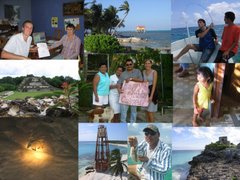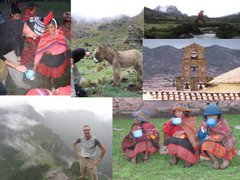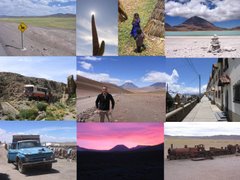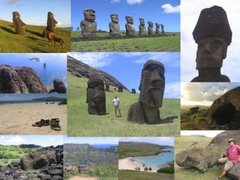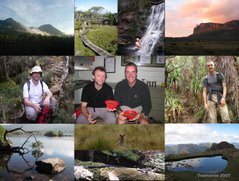
Wat Po temple in BangkokHere's a few random thoughts on being a traveller again:The Ultimate Form of Transport?You'd think that air-travel was a singularly technology-driven industry these days. What with instant telephone reservations and internet bookings and even being able to check-in online these days. Erm, not always.
Despite their appalling reputation ("It is worth flying with any other airline if at all possible" - Lonely Planet Nepal) and poor safety record (but then flying is the safest form of transport I thought*), I was attracted by Royal Nepal Airlines' cheap prices and decided to book a flight with them for the Bangkok to Kathmandu leg of the Bigtrip. However, deciding to do that and doing it were two different things. Firstly, RNA has no booking facility online. Secondly, travel agents in Australia won't deal with them.
The only solution was to go to the RNA office in Bangkok myself on the morning of the flight to pay for and pick up my ticket.
Finding the office was easier than I thought. Then the bad news. Flight cancelled. Technical problems. No flight until Friday. Maybe I should have expected as much. When the King of Nepal took a tour of Africa in 2005, half of Royal Nepal's flights were cancelled at short notice! Luckily, the beauty of not having booked and paid for a ticket was that I could go to the Thai airways office and book a flight for the next day with a serious airline.
MORAL: if an airline isn't organised enough to allow online booking, you probably shouldn't rely on them to get several hundred tonnes of metal and gadgetry up and down out of the sky to anything resembling a reliable timetable.*I've since checked - flying is not the safest form of transport. Train travel is safer.
So what do you do when you have an unexpected 24 hours in Bangkok?
Dye your hair blonde and go clubbing with the locals of course. Now I know this is really a Japan thing, but in the spirit of the craze of peoples from Asia with dark hair dying it blonde, i thought "when in Rome..."
I was a bit disappointed to have a day less in Nepal but I had a great day in Bangkok. Really didn't think I'd like this city, but - in spite of the appalling traffic - it was a really great, lively place to visit. The temple pictures on this page are all from Bangkok.
In the evening I went to a local bar where a band played Thai music and passable covers of western tunes. I had a beer and then ordered a whisky and coke, not realising that when you order whisky and coke you are ordering the whole bottle. This mistake seemed to impress the locals. Obviously I got nowhere near finishing the bottle, but it still cost about the equivalent of 3 whisky and cokes in Edinburgh - result!
Weirdest thing in Bangkok happened at the airport. Survabhaiyam (sp) airport opened at the end of 2006 and is an ultra-modern airport intended to cement Bangkok's position as a key hub in Asia. Not that I appreciated that as I had to get up very early for the flight, which always kills me. At the airport I went to have some breakfast at a Thai restaurant. The waitress was the strangest person I have ever met. She kept singing bizarre songs and wanting to touch the bottom of my trousers while I was eating my Chicken Noodle Soup. Then when I asked her not to, she sat behind me having an imaginary conversation with her mother about how she met this man one day and only wanted to touch his trousers because they were magical. I was so tired I could have wept. Luckily my flight was called and I managed to escape with my trousers...
MORAL: if you build the second-largest passenger terminal in the world and have to staff it in a hurry, don't expect to pick from the top of the job-seekers' pool.
 (Thailand is famous for its massages. An invigorating hour-long massage is just $3. An aromatherapy massage, including foot-washing, for 90 mins is only $5. You can have a sculpture made of yourself being massaged for just $10. Ok, I made that last one up.)
(Thailand is famous for its massages. An invigorating hour-long massage is just $3. An aromatherapy massage, including foot-washing, for 90 mins is only $5. You can have a sculpture made of yourself being massaged for just $10. Ok, I made that last one up.)
Out of all the restaurants I could have gone to at the airport, I happened to choose that one. Just chance or, when the coincidinces start piling up, do you need to ask if there is something else at work...?
What are the chances?
It's a big big world. And there are now 6,500,000,000 of us milling about on it. I worked out that, if you said hello to one person every second, you'd have to live to be 175 to meet everyone on earth*. I have had a lot of time on my hands recently now that they force you to check in 3 hours early.
I got onto thinking about that when I was wondering about going to visit the Dalia Lama in India (a visit to the hills around Shimla could be a perfect antedote to India's June heatwave). He must be the individual alive today who has met more ordinary people than any other.
 (Modern art or the back of the Buddha's head?)
(Modern art or the back of the Buddha's head?)
Anyway, for all the numbers, I actually want to make the point that this is a small world. Bear with me here...
Coincidence 1: I often get the funny feeling of seeing a familiar face when I'm travelling. Bizarrely, sometimes it's someone of a different race who happens to look like one of my friends. (Graeme - it's not just Jools Holland I'm concerned about!) However, this feeling was stronger than usual when I arrived at Siem Reap airport in Cambodia last weekend. As I waited at the luggage belt, an English-looking guy (you can spot travelling Brits a mile off, they tend to look a bit pasty and uptight at airports) seemed very familiar. Eventually we were next to each other in the taxi queue. After a mumbled hello he apologised for giving me the wrong directions when I asked him how to get the tram to the beach in Melbourne three months before! Really, what are the chances...???
Coincidence 2: The other day I emailed my friend Adrienne and happened to mention that I was just about to fly to Nepal for a week. She emailed back to say that she had just changed her plans and would arrive in Kathmandu a couple of days before I was due to leave. This will be second time our paths have crossed since we met in South America. And when was the other time...? When we were both in Melbourne and that guy gave us the wrong directions of course!!
* In fact, with about 20 people born every second, you could never actually get through the 6.5bn at all. (talking of which, if there's not 'one' but one-thousand 'born every minute', doesn't that mean that 99.9% of us should be quick-witted and not gullible...?)
 (Lastly, this is a picture of my expensive Merill sandals just before I threw them in the bin in Cambodia. The rot set in way back in January when I wore them to walk across the salt plains in Uyuni, Bolivia. That stuff is incredibly corrosive - it basically ate through my sandals over a period of several months. Travelling can be hard on your feet but even harder on your footwear.)
(Lastly, this is a picture of my expensive Merill sandals just before I threw them in the bin in Cambodia. The rot set in way back in January when I wore them to walk across the salt plains in Uyuni, Bolivia. That stuff is incredibly corrosive - it basically ate through my sandals over a period of several months. Travelling can be hard on your feet but even harder on your footwear.)
 (Local girls under the watchful eyes of the Buddha.)
(Local girls under the watchful eyes of the Buddha.) 
 very special place, dirty, dusty and incredibly noisy, but definitely, definitely unique. It was also my first introduction to Indian style poverty on the trip. I'd been to Sri Lanka before but wasn't fully ready for the onslaught of hawkers, wise-guys and scams.
very special place, dirty, dusty and incredibly noisy, but definitely, definitely unique. It was also my first introduction to Indian style poverty on the trip. I'd been to Sri Lanka before but wasn't fully ready for the onslaught of hawkers, wise-guys and scams. 
 (I had the good fortune to arrive in Kathmandu the day a public demonstration by the communists was taking place in the centre of the old town.)
(I had the good fortune to arrive in Kathmandu the day a public demonstration by the communists was taking place in the centre of the old town.) 
 re are 400+ years old, and provide perfect grandstands for public gatherings. RIGHT: though communism in Nepal is of a religiously tolerant type, not everyone seems convinced by the political rhetoric.
re are 400+ years old, and provide perfect grandstands for public gatherings. RIGHT: though communism in Nepal is of a religiously tolerant type, not everyone seems convinced by the political rhetoric.  were literally a bus-full of passengers on the flight and as the bus drove away from the terminal building I imagine that every one of my fellow passengers was, like me, nervously and silently speculating on which of the jumbled assortment of small aircraft would carry us between the highest mountains in the world.
were literally a bus-full of passengers on the flight and as the bus drove away from the terminal building I imagine that every one of my fellow passengers was, like me, nervously and silently speculating on which of the jumbled assortment of small aircraft would carry us between the highest mountains in the world. 



























